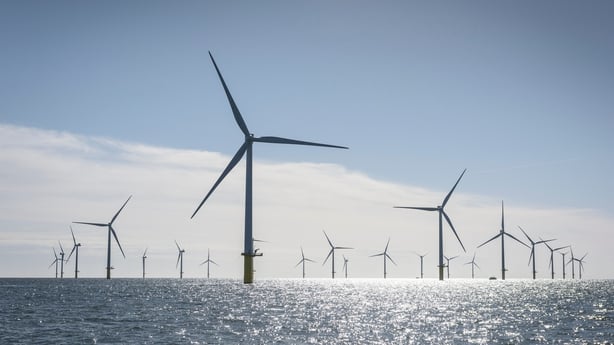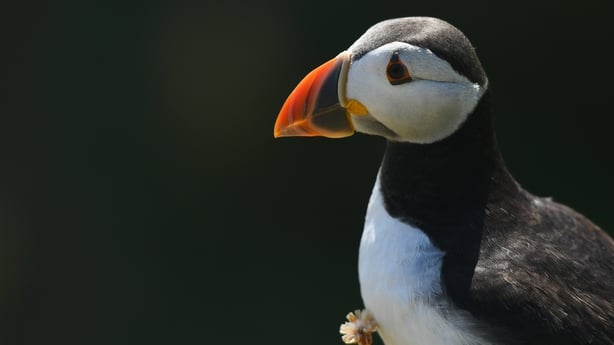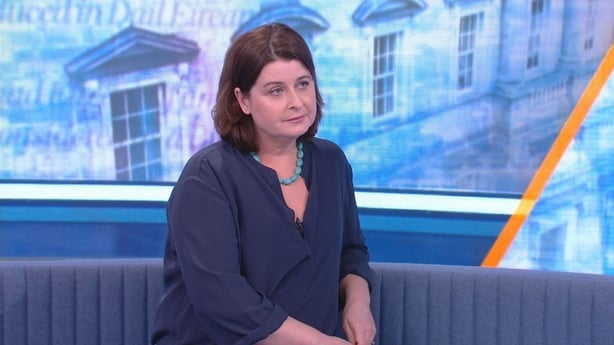Ireland is still six years away from generating energy from new offshore wind farms, according to Wind Energy Ireland, which says the first offshore turbines could be producing energy by late 2027 or early 2028.
"The expectation is that if we get our planning system right, if we get our grid system right, we could have the second offshore wind farm exporting energy onto the grid by late 2027 or early 2028," CEO of wind energy Ireland Noel Cunniffe said.
Huge hikes in energy prices and Russia's war in Ukraine have highlighted Ireland’s over-reliance on imported fossil fuels. Ireland is bound to generate 70% of its energy from renewable sources by 2030.
Speaking on RTÉ’s This Week programme, Mr Cunniffe said: "We now have targets in place to develop 5000 MW of offshore wind by 2030, enough to power 3.5 million homes.
"What that means is we’ll be developing seven to ten offshore wind projects over the next eight years. There’s an initial group of six projects - five off the east coast, one off the west coast."
Each new wind farm will be larger than any existing infrastructure project in Ireland, and each comes with a price tag of €3 billion to €5 billion.

Ireland already has one offshore wind project off Arklow. It began operations in 2004 and produces 25MW of wind energy. Since then, the country has fallen behind others including the UK, the Netherlands and China.
Peter Coyle, chairman of Marine Renewables Industry Association, said that is about to change.
Speaking on the same programme, he said Ireland has the potential to be the "Saudi Arabia of wind and wave".
"We have enormous wind resources and the world’s most bountiful waves. We just need to capitalise on those," he added.
In recent days, Minister for Climate Eamonn Ryan announced the next step in making renewable offshore wind electricity a reality.
Speaking on RTÉ's Morning Ireland last Monday ahead of the launch of a new maritime planning regime, Mr Ryan said the target which the Government set two years ago "was seen as a very ambitious target" at the time.
We need your consent to load this rte-player contentWe use rte-player to manage extra content that can set cookies on your device and collect data about your activity. Please review their details and accept them to load the content.Manage Preferences
He added "now because of what's happening in Ukraine, I think that's the minimum of our ambition".
Asked when proposed off-shore wind farms could be generating energy for Ireland, he said "in four years' time", adding: "We're going flat out, accelerating in every way we can".
Developers have been invited to apply for a Marine Area Consent. Successful applicants can then apply for full planning permission for wind turbines in the sea. But there are many problems and obstacles ahead.
The fishing industry is concerned that wind turbines will be placed on the best fishing grounds. John Lynch of the South and East Fish producers Organisation said that consultations to date have not gone well.
"They come to us with a map, and on the map they have outlined an area where they want to place their wind farm. But a lot of the time they've chosen a high density area for fishing. This is a big problem - particularly for the use of mobile fishing gear," Mr Lynch said.
"It’s going to cause conflict in the future if there is not some agreement or some benefit accruing to the fishing industry," he added.
There is also concern over the future of sea life in areas where wind farms are placed.
Oonagh Duggan of Birdwatch Ireland says huge offshore wind farms will impact feeding grounds used by birds.
"There are four sea birds that are already red listed, including the razorbill, puffin and kittiwake," she said.

If the wind industry wants to avoid more delays, Ms Duggan says marine life will have to be properly assessed. "I think developers take seriously the need to assess the impacts on birds.
"But sometimes the goal is to get the right answer - that there will be no significant effects. The industry will not have a good social licence to operate if biodiversity is destroyed," she said.
Social Democrats TD for Wicklow Jennifer Whitmore says three wind farms are planned for the county’s coast. She agrees offshore wind is needed but has called for balance between the need for energy security and the need to protect marine biodiversity.
"We’re moving quite quickly towards setting the planning framework to put wind farms in, but the framework to establish marine protected areas is not moving as quickly," she said.
Without marine protected areas, Ms Whitmore said there's risk wind farms could be located in the wrong areas.
"We need to identify areas of particular biodiversity and ecological importance and make sure they are protected."

Ms Whitmore also fears that if planning is not seen to be sufficient, offshore wind farms will be further delayed by judicial reviews.
"It is important that we get the system in place up front rather than relying on going through a court system later on," she said.
For offshore wind developers, timely planning decisions will be crucial to getting farms up and running in the next six years. Wind Energy Ireland says planning bodies don’t have the necessary resources.
"A brand-new area of expertise will be needed in An Board Pleanála," says Mr Cunniffe. "They really need the resources to scrutinise these planning applications."
The National Parks and Wildlife Service says it will have a planning role but is "dramatically underfunded".
Another question concerns the capacity of the national electricity grid.
In areas where windfarms will be located the grid needs to be able to accommodate the energy generated at sea.
Offshore wind, according to Peter Coyle of MRIA, is not a solution to the immediate energy problems caused by the war in Ukraine. But he says by 2040, offshore wind could make the country energy independent.







